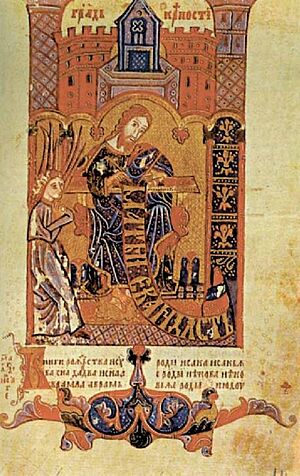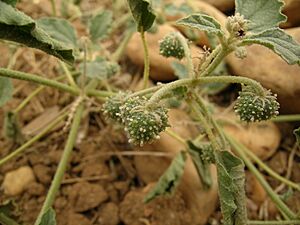Turnsole facts for kids

Turnsole or folium was a special dye. It came from a plant called Chrozophora tinctoria. This plant grows new every year.
A Dye from History
Turnsole became very popular in the 1200s. Artists used it to color beautiful old books. These books had amazing pictures and designs. Turnsole joined other plant-based dyes like woad and indigo.
Artists often used turnsole instead of a very expensive dye. This expensive dye was called Tyrian purple. It came from sea snails. But the best blue color came from a stone called lapis lazuli. This stone was ground into a fine powder. Turnsole was not as fancy as lapis lazuli. It was mostly used for shading. By the 1600s, artists stopped using turnsole much. Newer, easier-to-find blue colors became available.
Turnsole could make many colors. It made blue, purple, and red. The color changed depending on how acidic or alkaline its environment was. This is like a Litmus test, which you might know from science class. People in the Middle Ages did not understand why this happened.
The dye "folium" means "leaf." But it actually came from the plant's fruit. The fruit has three parts. Old recipes say the fruits must stay whole. The seeds should not come out when making the dye. People collected the fruits in late summer or early autumn.
In the early 1400s, an artist named Cennino Cennini wrote a book. It was called Libro dell' Arte. He wrote about how to color paper with turnsole. He also wrote about painting fabric with it. To dye fabrics, people would soak them. Then they put the fabrics in a damp cellar. The air in the cellar came from pans of urine. People did not know that the urine made a gas called ammonia. This gas helped the dye work. This shows that making dyes could be a bit smelly!
Turnsole was sold soaked into small pieces of linen cloth. People would then take the dye out of the cloth to use it. Scientists now know the color comes from a chemical called chrozophoridine.
Other Uses for Turnsole
Turnsole was also used to color food. An old cookbook from the 1400s mentions soaking it in milk. Another book from 1653 talks about grating turnsole into water. It was also used to dye the rind of some cheeses red. These cheeses came from the Netherlands.
Old plant books, called Herbals, described the turnsole plant. They said it grows on sunny, dry slopes in the Mediterranean area. They called it solsequium, which means "sun-follower." This is because its flowers turn to face the sun.
Medicinal Uses
Some people thought turnsole had healing powers. This idea came from ancient texts. A doctor named Dioscorides wrote about it in the first century AD. Medieval medicine books also mentioned it. However, modern studies in the 2000s have shown it does not have strong anti-inflammatory effects.


